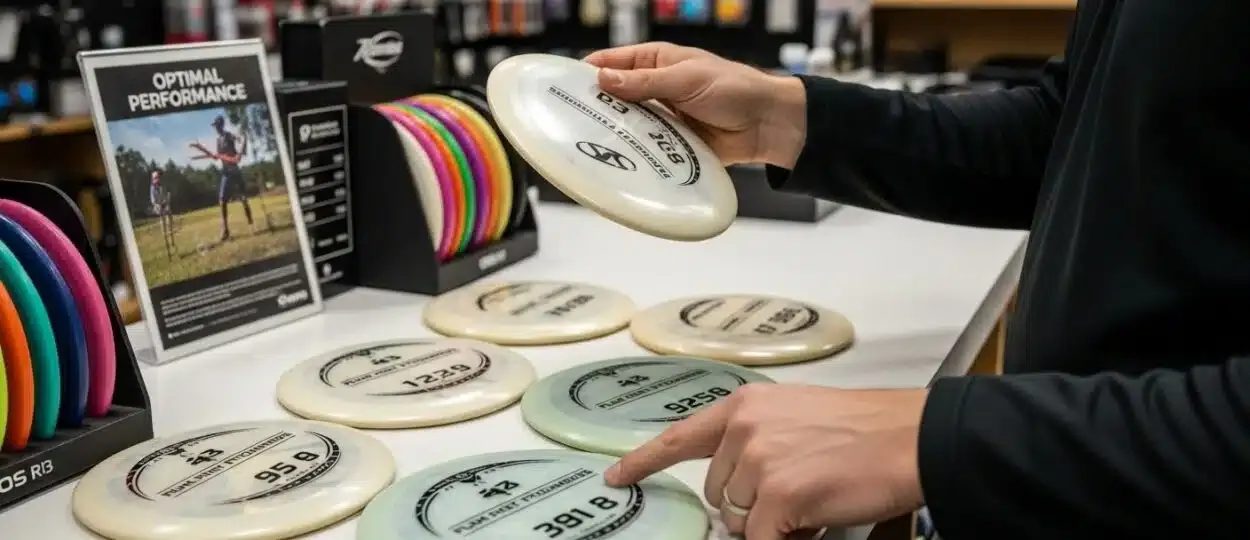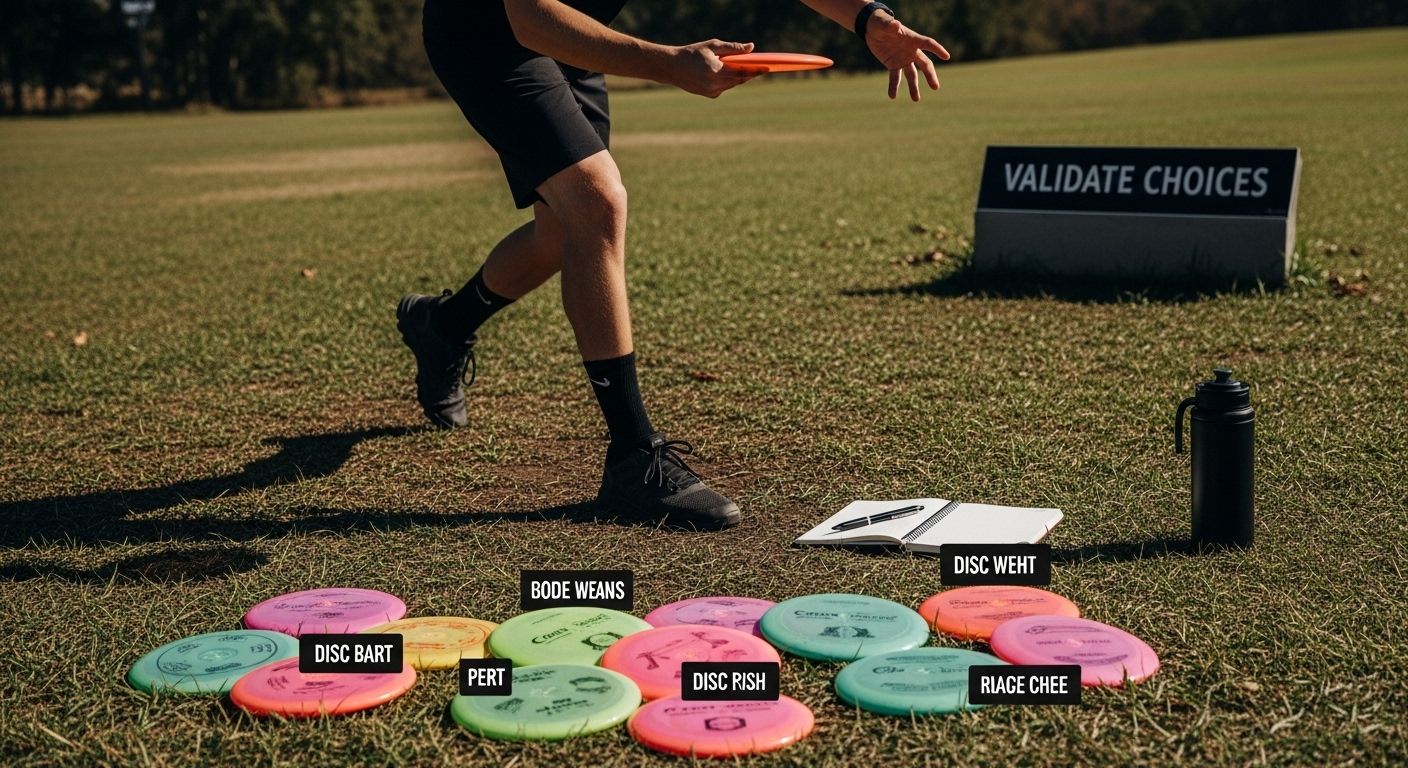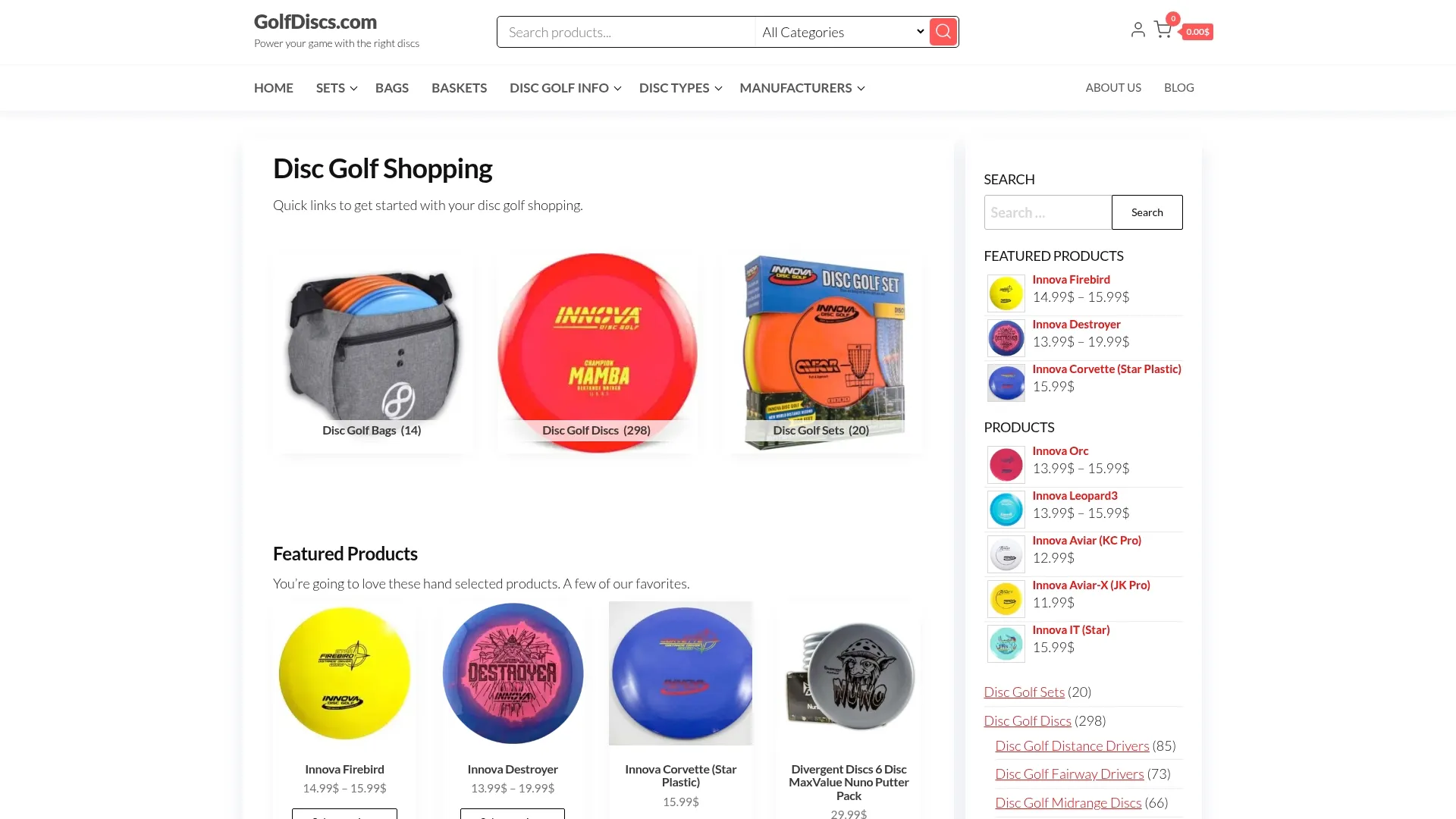
How to Choose Disc Golf Discs for Optimal Performance
Choosing the right disc golf discs can shape your entire experience on the course. Most new players make the same mistake and pick discs that actually slow their progress rather than help it.
The real secret is that beginners who use understable discs with lower speed ratings see faster improvement and more accurate throws than those who reach for high-speed drivers first. This flips the usual advice on its head and can make all the difference in your game.
Table of Contents
- Step 1: Evaluate Your Skill Level And Play Style
- Step 2: Understand The Different Types Of Discs
- Step 3: Determine The Right Disc Weight And Size
- Step 4: Test Discs For Comfort And Performance
- Step 5: Make Your Selection And Purchase Discs
- Step 6: Validate Your Choices Through Practice
Quick Summary
| Key Point | Explanation |
|---|---|
| 1. Evaluate skill and play style | Know your throwing strength and style to choose suitable discs that aid your growth. |
| 2. Understand disc types and functions | Familiarize yourself with putters, midranges, and drivers to enhance your game. |
| 3. Choose appropriate disc weight | Select lighter discs for better control; adjust as strength and skill improve. |
| 4. Test discs for comfort and performance | Experiment with different discs to find the best fit for your throwing technique. |
| 5. Practice consistently to validate choices | Regular practice with chosen discs helps develop skill and confidence in performance. |
Step 1: Evaluate Your Skill Level and Play Style
Choosing the right disc golf discs begins with a critical self-assessment of your current skill level and playing style. This foundational step determines the types of discs that will help you develop your technique and improve your game. New players often make the mistake of selecting discs beyond their current skill range, which can lead to frustration and slower skill progression.
Start by honestly evaluating your physical capabilities, throwing strength, and current disc golf experience. Are you a complete beginner who has never thrown a disc before? Or are you transitioning from casual recreational play to more serious competitive practice? Experienced players typically have more control over disc stability, speed, and release techniques compared to newcomers.
For beginners, the focus should be on understable discs with lower speed ratings that are more forgiving during throws. These discs help develop proper throwing mechanics and provide greater accuracy. Midrange discs and lighter weight drivers between 150-165 grams are typically recommended for those just starting. As you progress, you’ll want to gradually introduce more stable and faster discs that match your increasing skill level.
Your throwing style also significantly impacts disc selection. Some players naturally throw with a strong backhand technique, while others prefer forehand or have a more hybrid approach. Understanding your dominant throwing motion helps select discs that complement your natural movement. Check out our guide on mastering throwing techniques to refine your understanding of different throwing styles and their disc requirements.
To verify you’ve completed this step effectively, assess whether the discs you’re considering align with your current skill level. Signs of a good match include consistent throw accuracy, comfortable grip, and gradual improvement in distance and control. Remember, disc golf is a journey of continuous learning and adaptation.
Step 2: Understand the Different Types of Discs
Navigating the world of disc golf requires a comprehensive understanding of disc types, each designed for specific purposes and playing conditions. Every disc in your bag serves a unique function, much like different clubs in traditional golf. The primary disc categories include putters, midrange discs, fairway drivers, and distance drivers, each with distinct characteristics that impact their flight and performance.
Below is a quick reference table comparing the main types of disc golf discs, their typical uses, and which skill levels should focus on each. This will help you easily identify which discs to seek out as you build your set.
| Disc Type | Typical Use | Key Characteristics | Recommended For |
|---|---|---|---|
| Putter | Short-distance shots, final throws | Slowest speed, thickest rim, max control | All skill levels |
| Midrange | Approaches, medium-range shots | Versatility, accuracy, moderate speed | Beginners & up |
| Fairway Driver | Controlled, moderate-distance shots | Predictable flight, moderate distance | Developing/intermediate |
| Distance Driver | Maximum range, long throws | Fastest speed, narrowest rim, requires skill | Advanced players |
| Understable Disc | Easy to throw straight, improved accuracy | Curves right for RHBH, forgiving | Beginners |
| Stable Disc | Straight flight, consistent path | Neutral flight | Beginners & up |
| Overstable Disc | Strong fade at end of flight | Curves left for RHBH, wind resistant | Experienced players |
Putters are the most critical discs in your collection, used for short-distance shots and making final throws into the basket. They feature the slowest speed ratings and thickest rims, providing maximum control and stability.
Midrange discs bridge the gap between putters and drivers, offering versatility for shots between 50 and 300 feet. These discs provide excellent accuracy and are perfect for players developing their throwing techniques. Explore our comprehensive guide to disc golf disc types to understand how each disc contributes to your game.
Drivers are divided into two primary categories: fairway drivers and distance drivers. Fairway drivers are designed for controlled, precise shots with moderate distances, typically ranging from 250 to 350 feet. They offer more predictable flight paths and are ideal for players developing consistency in their throws. Distance drivers, conversely, are engineered for maximum range and speed, featuring narrower rims and more aggressive flight characteristics. These discs require significant arm speed and technical skill to control effectively.
Understanding disc stability is equally crucial. Discs are classified as overstable, stable, or understable, which describes their tendency to curve during flight. Overstable discs fade hard to the left for right-handed backhand throws, stable discs maintain a straighter trajectory, and understable discs tend to turn right before fading back. Beginners should focus on stable and understable discs, gradually introducing more challenging disc types as their skills improve. Proper disc selection can dramatically enhance your performance and enjoyment of the game.
Step 3: Determine the Right Disc Weight and Size
Selecting the appropriate disc weight and size is a nuanced process that significantly impacts your throwing performance and overall disc golf experience. Disc weight influences flight characteristics, control, and your ability to manage different throwing techniques. Beginners often overlook this critical aspect, assuming all discs perform identically regardless of their weight.
For new players, lighter discs between 150 and 165 grams are typically recommended. These lighter discs require less throwing power and provide more predictable flight paths, helping players develop consistent throwing mechanics. Heavier discs, ranging from 170 to 180 grams, demand more arm strength but offer increased wind resistance and stability. Discover the perfect disc weight for your skill level to optimize your game strategy.
Disc diameter plays an equally important role in your selection process. Standard disc golf discs range between 21 and 21.2 centimeters in diameter, with slight variations depending on the disc type. Putters typically have wider rims and larger diameters, providing better grip and control for short-distance shots. Drivers, particularly distance drivers, feature narrower rims and smaller diameters to maximize aerodynamic performance and potential throwing distance.
Physical factors like hand size and grip strength also influence your ideal disc weight and size. Players with larger hands might find it more comfortable to throw slightly heavier discs, while those with smaller hands could benefit from lighter options that allow for more precise grip and release. Experimenting with different disc weights during practice sessions will help you understand how weight impacts your throwing technique. A successful selection process means finding discs that feel natural in your hand, complement your throwing style, and provide consistent performance across various playing conditions.
Here is a checklist table to help verify you have successfully completed the essential steps when choosing and testing your first disc golf discs.
| Step Description | Completion Criteria / What to Check |
|---|---|
| Skill Level & Play Style Assessed | Discs match your current skill, throwing feels natural |
| Disc Types Researched | Understand the role of putter, midrange, fairway & distance drivers |
| Correct Weight/Size Selected | Discs feel comfortable in hand, manageable weight |
| Comfort/Performance Tested | Tried several discs, comfortable grip, predictable flight paths |
| Disc Selection & Purchase Completed | Bought 3-4 essential discs that match your findings |
| Practice/Validation Performed | Regular practice, noting improvement, confidence, and consistency |
Step 4: Test Discs for Comfort and Performance
Testing discs for comfort and performance is a critical step that transforms theoretical knowledge into practical skill development. Hands-on experience provides invaluable insights that cannot be gained through reading descriptions or listening to recommendations. This stage allows you to understand how different discs interact with your unique throwing mechanics, grip strength, and physical capabilities.
Begin your testing process by visiting a local disc golf store or attending a practice session where you can handle multiple disc types. Many specialty stores and disc golf courses offer rental or demo discs that enable players to experiment without significant financial investment. Pay close attention to how each disc feels in your hand, noting grip comfort, rim width, and overall weight distribution. Some discs might feel awkward initially, while others will seem like natural extensions of your throwing motion.
Learn advanced disc testing techniques to refine your selection process. When testing, focus on consistent throwing techniques across different discs to create a fair comparison. Practice various throws including backhand, forehand, and overhead releases to understand how each disc responds to different motion styles. Record your observations about flight patterns, distance achieved, and overall control. Experienced players recommend testing at least three to five discs in each category (putter, midrange, driver) to develop a comprehensive understanding of your preferences.
Verify your testing success by assessing key performance indicators. A well-tested disc should provide predictable flight paths, feel comfortable during release, and match your current skill level. Signs of a good disc match include consistent accuracy, comfortable grip, and a sense of confidence when throwing. Remember that disc selection is a personal journey, and what works perfectly for one player might feel completely different for another. Embrace the exploration process, remain patient with yourself, and enjoy discovering the nuanced world of disc golf equipment.
Step 5: Make Your Selection and Purchase Discs
Making your final disc selection requires careful consideration of everything you have learned through previous steps. The moment of purchase represents the culmination of your research, testing, and personal exploration of disc golf equipment. Your goal is not just to buy discs, but to invest in tools that will support your skill development and enjoyment of the game.
Start by creating a strategic purchasing plan that prioritizes your immediate needs. For beginners, this typically means acquiring 3-4 essential discs: a putter, a midrange disc, and one or two fairway drivers. Quality always trumps quantity, so focus on selecting discs from reputable manufacturers known for consistent manufacturing standards. Explore budget-friendly disc purchasing strategies to maximize your investment without compromising performance.
When making your purchase, consider buying from specialized disc golf retailers or pro shops where knowledgeable staff can provide personalized recommendations. Online stores offer convenience and often wider selections, but local shops provide the advantage of immediate handling and expert advice. Compare prices across multiple platforms, looking not just at cost but also at return policies, warranty information, and shipping expenses. Some retailers offer beginner disc sets that provide excellent value and carefully curated disc combinations tailored to new players.
Verify the success of your selection by checking that your purchased discs align with the comfort and performance characteristics you identified during testing.
![]()
A successful purchase means feeling confident with your discs, understanding their potential flight paths, and being excited to practice and improve your technique. Remember that your first set of discs is just the beginning of your disc golf journey, and your collection will naturally evolve as your skills progress.
Step 6: Validate Your Choices Through Practice
Validating your disc choices through consistent, intentional practice transforms theoretical knowledge into tangible skill development. Practice is the ultimate proving ground for your disc selection, where you will discover the true compatibility between your throwing technique and your chosen equipment. This step moves beyond mere equipment acquisition and focuses on developing a deep understanding of how your discs perform in real-world conditions.
Begin your validation process by establishing a structured practice routine that systematically explores each disc’s capabilities. Start with shorter, controlled throws in an open field, focusing on consistent release techniques and observing how different discs respond to your throwing motion. Uncover advanced practice techniques that will accelerate your skill development and disc understanding. Pay attention to subtle variations in flight paths, noting how factors like wind, terrain, and your throwing angle impact disc performance. Photograph or video record your practice sessions to create a visual reference that allows you to analyze your technique and disc behavior more objectively.
As you progress, introduce more complex throwing scenarios that simulate actual disc golf course challenges. Practice throwing from various lies, navigating around imaginary obstacles, and executing different shot types like hyzers, anhyzers, and rollers. Your goal is to develop muscle memory and an intuitive understanding of each disc’s unique flight characteristics. Keep a practice journal documenting your observations, including disc type, weight, throwing conditions, and performance metrics. Signs of successful disc validation include consistent accuracy, predictable flight paths, and a growing sense of confidence in your ability to control each disc.

Remember that disc validation is an ongoing process, and your understanding will continue to deepen with each practice session, ultimately leading to more refined technique and greater enjoyment of the game.
Take the Guesswork Out of Choosing Your Disc Golf Discs
Sifting through endless choices when picking disc golf discs can feel overwhelming. You’ve just learned how the right disc selection—whether it’s the ideal weight, perfect grip, or matching your skill level—can elevate your game. If you find yourself frustrated by unpredictable throws or struggling to spot real improvement, you are not alone. Many players face these same challenges and waste time and money on discs that simply do not fit their needs.

Ready to put your new knowledge into action? Visit golfdiscs.com and explore our wide selection of hand-picked disc golf discs and equipment designed for every player. Discover tools that match your playing style and support your individual progress. Don’t let uncertainty slow your game. Start shopping at golfdiscs.com so you can practice smarter, play with confidence, and notice real results this season.
Frequently Asked Questions
How do I determine my disc golf skill level for selecting discs?
Assess your skill level by considering your experience, throwing strength, and techniques. Beginners should focus on understable discs with lower speed ratings, while experienced players may opt for more stable, faster discs.
What types of disc golf discs should I include in my bag as a beginner?
As a beginner, focus on acquiring 3-4 essential discs: a putter for short shots, a midrange disc for versatility, and one or two fairway drivers for controlled distances. This foundation helps you develop your skills effectively.
How does disc weight affect my performance in disc golf?
Disc weight influences flight characteristics and control. Lighter discs (150-165 grams) are ideal for beginners as they require less power and offer predictable flights. Heavier discs (170-180 grams) provide greater stability but require more arm strength to control.
What should I focus on when testing disc golf discs for comfort and performance?
When testing discs, pay attention to grip comfort, rim width, and overall weight distribution. Practice various throws like backhand and forehand to assess how each disc behaves with your throwing style. Look for predictable flight paths and consistent accuracy.
